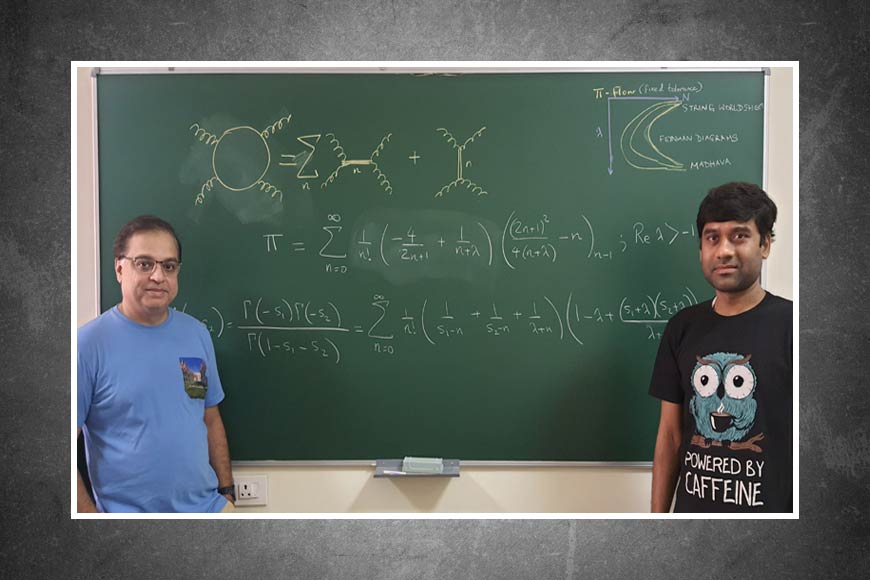Two Bengali physicists find a path-breaking new series representation of Pi – GetBengal story

The ratio of a circle's circumference to its diameter, or π (/pa˪/; abbreviated as "pi"), is a mathematical constant that is roughly equivalent to 3.14159. A lot of formulas in physics and mathematics use π. Since it is a transcendental number, an equation including only finite sums, products, powers, and integers cannot have it as a solution. This implies that it is impossible to solve the ancient challenge of squaring the circle with a compass and straightedge. The decimal digits of pi seem to be distributed randomly, but no evidence to support this has been discovered.
Two Bengali physicists have recently created quite a stir in the scientific world with their discovery, which has opened the gates to new possibilities and can transform the world in the future. Dr. Anindya Sinha and Arnab Saha, physicists at the Indian Institute of Science (IISc), have found a new formula for pi that simplifies calculations in high-energy particle interactions.
The goal of the research, headed by Professor Aninda Sinha and post-doctoral researcher Arnab Saha from the Centre for High Energy Physics (CHEP), was to create a model for understanding particle interactions that had fewer, more precise parameters. Their work led to the discovery of a novel series representation for the irrational number π, which made computations in quantum physics easier.
Mathematicians have been attempting to precisely calculate the value of pi for thousands of years. For practical computations, ancient civilisations such as the Babylonians and Egyptians needed precise estimations of π. The Greek mathematician Archimedes developed a technique to calculate π with accuracy in 250 BC. Using geometrical methods, mathematicians from China and India approximated π to seven and five digits, respectively, in the fifth century AD. The Welsh mathematician William Jones is credited with using the Greek letter π to denote the ratio of a circle's circumference to its diameter as early as 1706.
Soon after calculus was developed, hundreds of digits of pi could be calculated. However, new methods have been developed by mathematicians and computer scientists in the 20th and 21st centuries, which, when coupled with increased computing power, have allowed the decimal representation of π to reach several trillions of digits.
The Bengali physicists had initially been studying high-energy physics in quantum theory and attempting to develop a model with fewer and more accurate parameters to understand how particles interact. Their research led to the discovery of a novel way to look at π. In fact, Sinha’s research group had been working on string theory, the theoretical framework that presumes that all quantum processes in nature simply use different modes of vibrations plucked from a string. Their work focuses on the manner in which we can examine high-energy particle interactions using the fewest and most basic components conceivable, such as protons smashing together in the Large Hadron Collider. This method of expressing intricate relationships falls under the heading of "optimisation problems." It is difficult to model such processes because each moving particle has a number of factors that must be considered, including its mass, vibrations, degrees of freedom, and so forth.
Saha was searching for an effective approach to depicting these particle interactions while working on the optimisation problem. He and Sinha made the decision to combine two mathematical tools—the Feynman Diagram and the Euler-Beta Function—in order to create an effective model. Euler-Beta functions are mathematical functions used to solve problems in diverse areas of physics and engineering, including machine learning. The energy exchange that takes place when two particles encounter and scatter is explained mathematically by the Feynman Diagram. The group discovered a series representation of π in addition to an effective model that might explain particle interaction.
A series is used in mathematics to describe a parameter in its component form, like π. If π is the "dish,” then the series is the "recipe." It can be represented as a combination of many numbers of parameters (or ingredients). It has proven difficult to determine the right number and mix of these criteria to quickly approach the exact value of π. The series that Sinha and Saha have stumbled upon combines specific parameters in such a way that scientists can rapidly arrive at the value of pi, which can then be incorporated in calculations, like those involved in deciphering the scattering of high-energy particles.
Physicists (and mathematicians) have missed this so far because they did not possess the right tools. Although this line of research was pursued briefly in the early 1970s, it was given up on because of difficulties. Despite the fact that the results are still theoretical, it is feasible that they will eventually find practical use. Both Dr. Sinha and Dr. Saha feel that while this kind of work may not see immediate application in daily life, working on theory just for the sake of doing it gives immense pleasure and satisfies the urge to discover newer avenues of science.
Image Courtesy : the Indian Institute of Science











